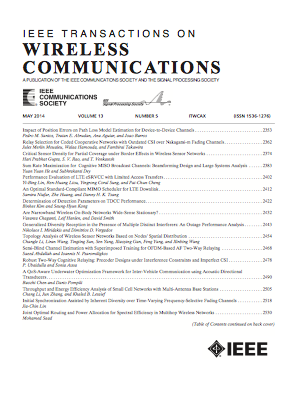用于无线通信的柔性天线阵列:建模和性能评估
IF 10.7
1区 计算机科学
Q1 ENGINEERING, ELECTRICAL & ELECTRONIC
引用次数: 0
摘要
柔性天线阵列(FAAs)以其可旋转、可弯曲和可折叠的特性而闻名,广泛应用于柔性无线电系统中,以实现定制的辐射模式。本文旨在说明FAAs能够动态调整表面形状,在多径信道功率和信道角cram本文章由计算机程序翻译,如有差异,请以英文原文为准。
Flexible Antenna Arrays for Wireless Communications: Modeling and Performance Evaluation
Flexible antenna arrays (FAAs), distinguished by their rotatable, bendable, and foldable properties, are extensively employed in flexible radio systems to achieve customized radiation patterns. This paper aims to illustrate that FAAs, capable of dynamically adjusting surface shapes, can enhance communication performances with both omni-directional and directional antenna patterns, in terms of multi-path channel power and channel angle Cramér-Rao bounds. To this end, we develop a mathematical model that elucidates the impacts of the variations in antenna positions and orientations as the array transitions from a flat to a rotated, bent, and folded state, all contingent on the flexible degree-of-freedom. Moreover, since the array shape adjustment operates across the entire beamspace, especially with directional patterns, we discuss the sum-rate in the multi-sector base station that covers the 360° communication area. Particularly, to thoroughly explore the multi-sector sum-rate, we propose separate flexible precoding (SFP), joint flexible precoding (JFP), and semi-joint flexible precoding (SJFP), respectively. In our numerical analysis comparing the optimized FAA to the fixed uniform planar array, we find that the bendable FAA achieves a remarkable 156% sum-rate improvement compared to the fixed planar array in the case of JFP with the directional pattern. Furthermore, the rotatable FAA exhibits notably superior performance in SFP and SJFP cases with omni-directional patterns, with respective 35% and 281%.
求助全文
通过发布文献求助,成功后即可免费获取论文全文。
去求助
来源期刊
CiteScore
18.60
自引率
10.60%
发文量
708
审稿时长
5.6 months
期刊介绍:
The IEEE Transactions on Wireless Communications is a prestigious publication that showcases cutting-edge advancements in wireless communications. It welcomes both theoretical and practical contributions in various areas. The scope of the Transactions encompasses a wide range of topics, including modulation and coding, detection and estimation, propagation and channel characterization, and diversity techniques. The journal also emphasizes the physical and link layer communication aspects of network architectures and protocols.
The journal is open to papers on specific topics or non-traditional topics related to specific application areas. This includes simulation tools and methodologies, orthogonal frequency division multiplexing, MIMO systems, and wireless over optical technologies.
Overall, the IEEE Transactions on Wireless Communications serves as a platform for high-quality manuscripts that push the boundaries of wireless communications and contribute to advancements in the field.

 求助内容:
求助内容: 应助结果提醒方式:
应助结果提醒方式:


